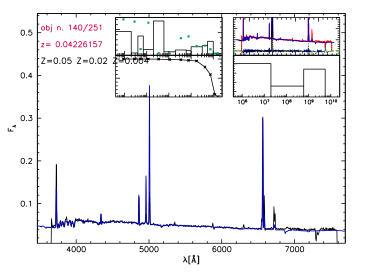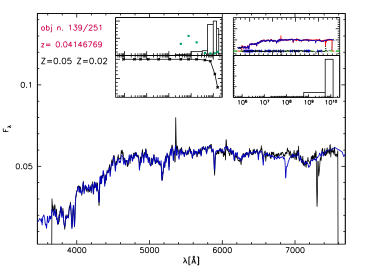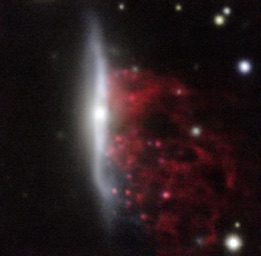WINGS & GASP


WINGS is the WIde-field Nearby Galaxy-cluster Survey. It was conceived as a nearby counterpart of higher redshift surveys such as EDiSCs and MORPHS to study, for the first time in a complete way, an X-ray selected sample of galaxy clusters.
I have developed a spectrophotometric code to automatically analyze the ∼6500 optical spectra collected by the companion WINGS-SPE spectroscopic survey, which enabled us to derive, stellar masses and ages, star formation rates and star formation histories and extinctions. See Fritz et al. (2007) and Fritz et al. (2011) for details on the code.
More details on the survey and its products and results can be found here.
Below you can find a couple of examples of fits to a couple of spectra, together with the star formation history reconstruction.
(Left panel) Fit to the spectrum of an early-type galaxy. The black line in the main window is the observed spectrum, while the blue one is the model, obtained as the sum of SSP spectra of different ages. In the insets the star formation rate as a function of the SSPs' age is displayed (leftmost inset) as histograms on the top, while the cumulative stellar mass built-up is represented on the lower panel, same inset. (Right panel) Similar to the left panel, but for a late-type spectrum.


A new method to automatically measure the equivalent width of spectral lines was developed to properly reproduce their value in the model spectrum. This method is particularly suited for intermediate resolution spectra where the signal-to-noise is NOT optimal. See this paper for further information. If you are interested in a standalone version of this code, feel free to drop me a line. A python version is also currently being developed, containing several improvements with respect to the original code.
From the roots of this code, I have developed SINOPSIS, an almost full panchromatic SED fitting code which uses both the spectral and the broad-band information.
GASP
(GAs Stripping Phenomena in galaxies with MUSE)
This is an ESO large program (P.I. is Dr. Bianca M. Poggianti, @ INAF, Padova observatory) that is observing a sample of so-called Jelly-Fish galaxies, that is galaxies with clear signs of gas stripping. Using the MUSE integral field unit at the VLT, it will shed light on the gas stripping mechanisms as a function of the environment and of the galaxies properties.
The quality of the spectra is just amazing, and SINOPSIS will be used for the analysis of the spatially-resolved stellar populations properties.
The survey has just been completed, and all the 114 galaxies have been observed. The analysis is being carried on for the whole sample, and some UV, radio and sub-mm follow up have been already done, while some others are on their way. 15 papers of the survey have been already accepted, and more are about to be.
FEATURED IN NATURE:
GASP uncovers new mechanisms to trigger AGN activity in Jellyfish galaxies.

6 out of 7 galaxies we have analyzed display this properties. Now, if you think that the typical occurrence of AGN in galaxies in the local universe is approximately 1/10, and that this happens even less frequently in cluster, it is quite evident that this numbers are telling us something. The most likely explanation is that the Ram Pressure Stripping, the mechanism that is responsible for the formation of the trails and tentacles, is also triggering the nuclear activity. This seems hence another way through which an AGN is ignited.
Paper VII from the GASP series made it to “Nature”. You can check it out here.
See also the ESO press release here.
Stay tuned for news, and check the GASP website here.
Check out here the poster at the AGN conference held in Durham: “Are AGN special? The environmental dependence and global impact of AGN activity”, between July the 30th and August the 4th, 2018.
GASP PUBLICATIONS
GASP publications have become to many. Instead of updating them here, I thought you could have a look at them here.
